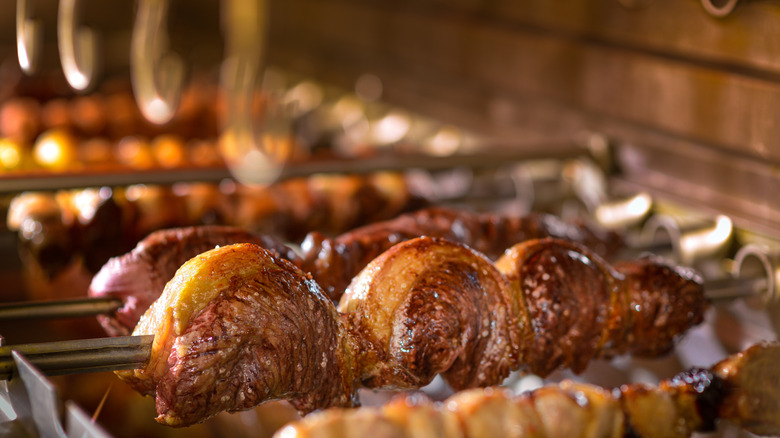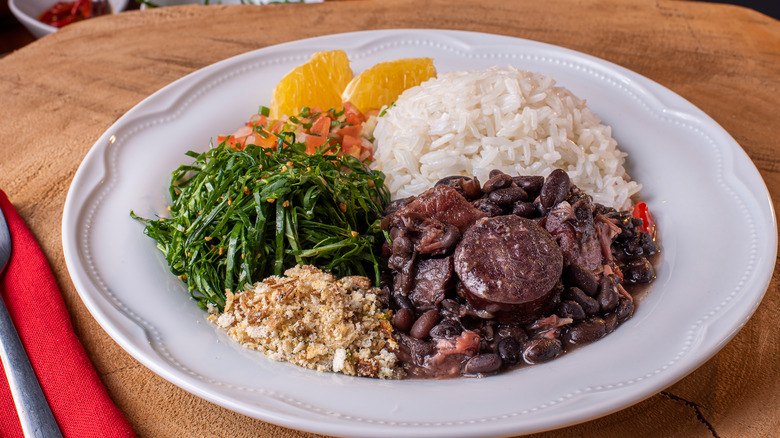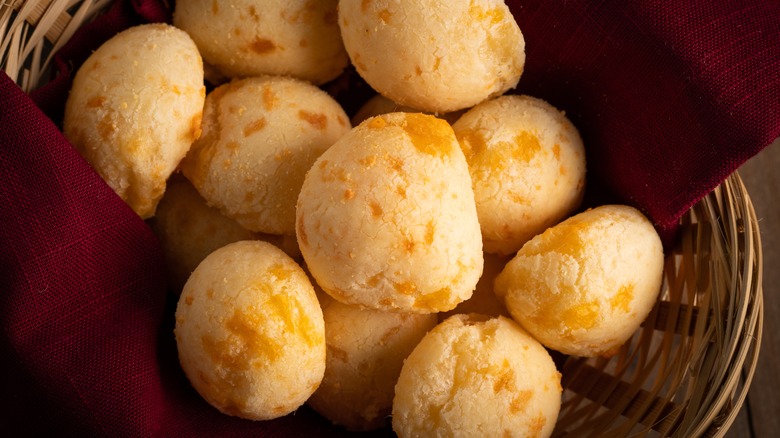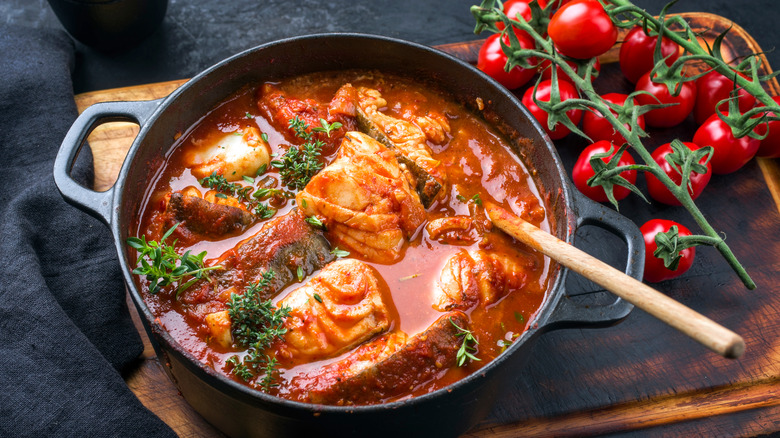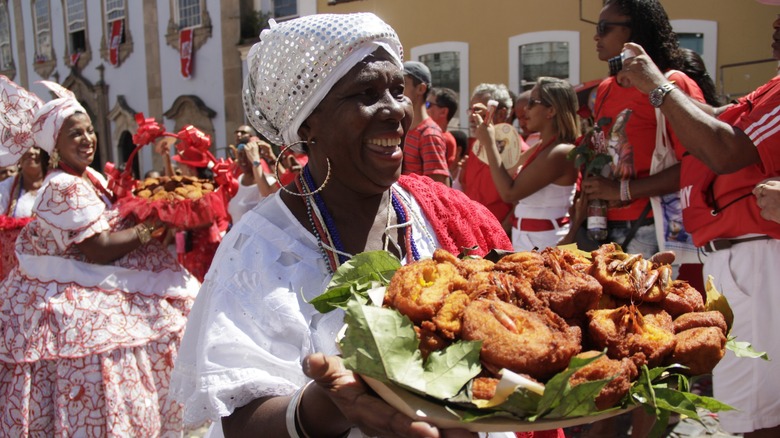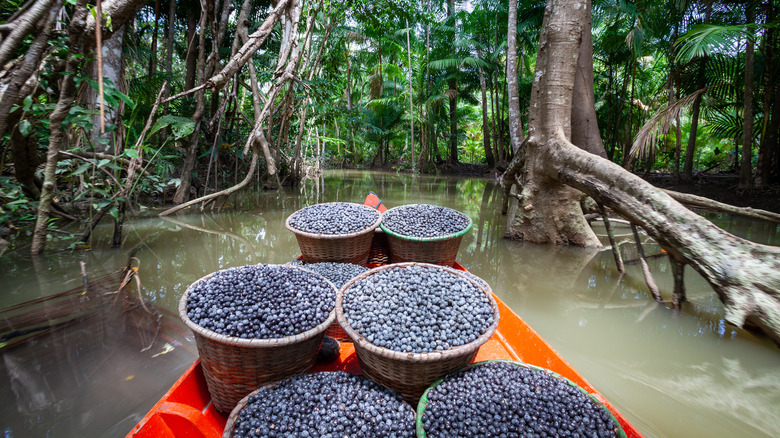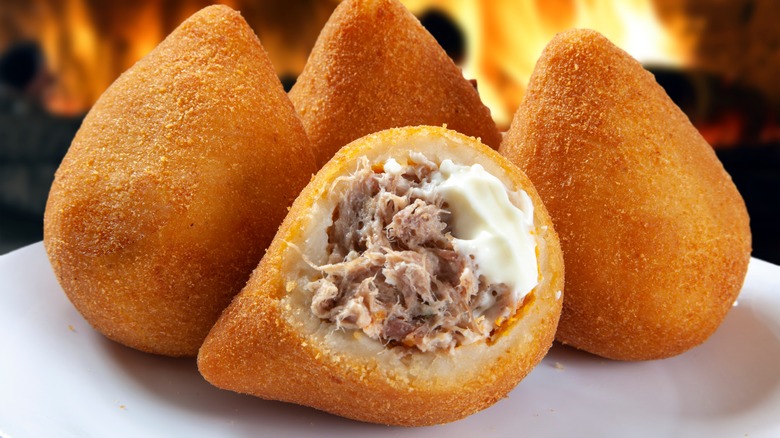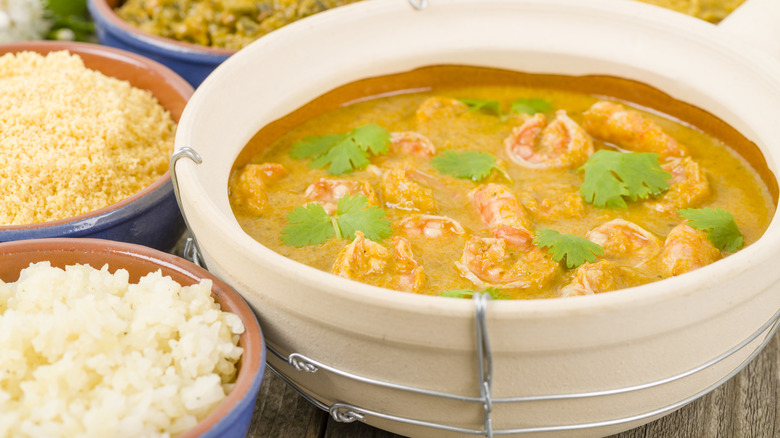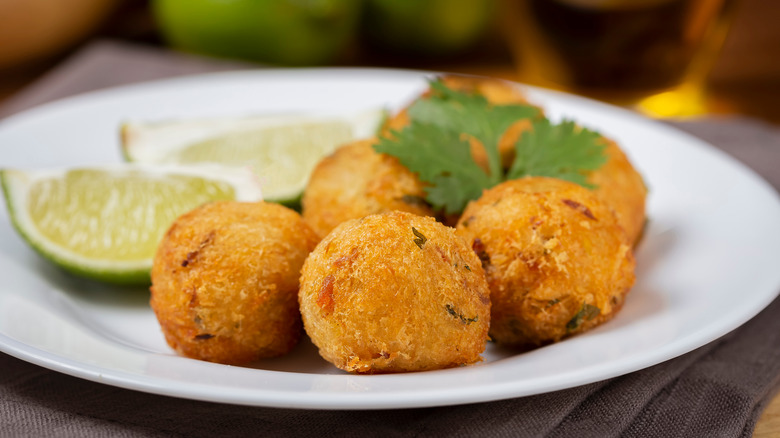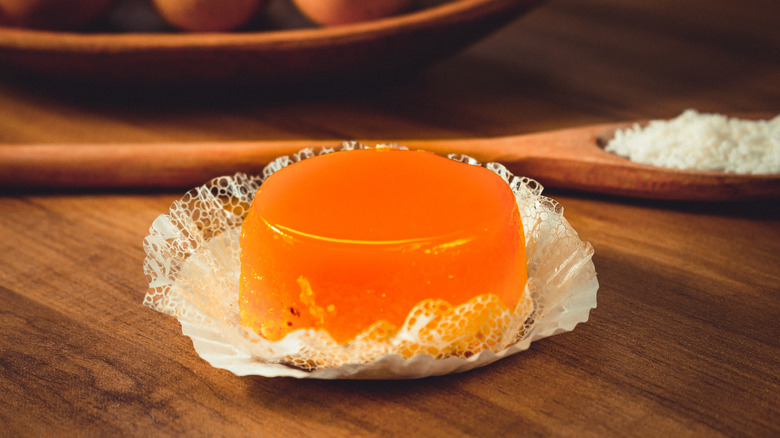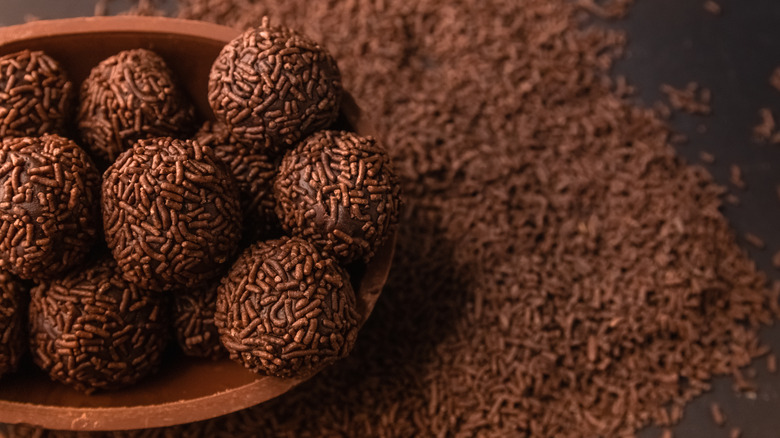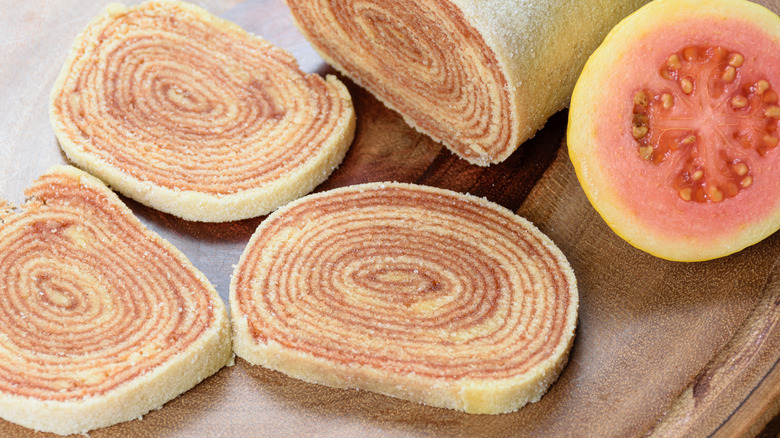Iconic Brazilian Foods You Need To Try Before You Die
Brazil's cuisine is as complex and colorful as the nation's history. Colonized by Portugal in the 16th century, Brazil, unlike other South American countries, adopted Portuguese, rather than Spanish as its official language. And the Portuguese influence is evident in Brazilian cuisine, in everything from the names of favorite dishes to the extensive use of favorite Portuguese ingredients (such as salt cod) to traditional Portuguese cooking strategies (such as using large numbers of egg yolks in desserts).
But when Portuguese explorers landed in what is now Brazil, they didn't land in a cultural blank slate. The region's many indigenous groups had their own age-old cuisines, all incorporating the rich variety of fish and wild produce available in the Amazon rainforest. Today, indigenous Brazilian ingredients such as cassava and açai have become central parts of Brazilian cuisine and are employed by Brazilian cooks of all origins. And enslaved Africans, originally brought to the country to work its sugarcane fields, brought their own culinary traditions, including the use of dried seafood and ingredients such as yams and black-eyed peas. Over the centuries, creative cooks combined these culinary traditions to create the mouth-watering delicacies for which Brazil is now known. Here are a few you absolutely must try.
Feijoada
Often referred to as Brazil's national dish, feijoada (named for the Portuguese word for "bean"), is not just a dish but an event — it's so commonly associated with celebrations and get-togethers that Brazilians call Saturday "the day of feijoada" (via Smithsonian Magazine). And it's easy to see why it's become Brazil's party dish of choice: Feijoada is not only delicious and reasonably affordable but also lends itself to being made in large quantities. A meal in itself, feijoada is a rich stew of simmered black beans, several types of meat (including dried beef, smoked pork spareribs, sausage, and sometimes beef tongue and pigs' ears), and a crunchy, crumbly topping of toasted manioc flour. It is almost always served with rice, stewed collard greens, and sliced oranges. If you're thinking this sounds like a tropical version of French cassoulet, you'd be right.
Feijoada is commonly thought to have been developed by Brazil's enslaved people, who spiced up their boiled black beans, an easily obtainable dietary staple, with whatever scraps of meat they could find. But recent scholarship reveals that even these scraps of meat were highly sought after in Brazil's early history, and would more likely be served to the masters of the estate than those serving them. Scholars also point out it bears a closer resemblance to traditional Portuguese stews than African ones. But no matter its roots, Brazilians of all origins now enjoy it — and it's well worth seeking out if you have the opportunity.
Pao de queijo
Brazil's answer to French gougères, pao de queijo (literally, "cheese bread") is a warm bite of cheesy goodness. Crunchy on the outside and soft and chewy inside, these popover-like treats are a common side dish as well as a popular breakfast dish. But unlike gougères or popovers, pao de queijo contain no wheat flour. Instead, their structure comes from tapioca starch, a derivative of cassava, a native plant of Brazil. Thus, as noted by The Guardian, their presence on the Brazilian table can be credited in part to the Guaraní, an indigenous group of southeast Brazil, who developed an effective (but labor-intensive) method of rendering the naturally toxic root safe to eat. This method involved peeling, grating, and repeatedly soaking and rinsing the cassava to leach out its naturally occurring cyanide — not a responsibility to be taken lightly.
One of the edible byproducts of this process is tapioca flour — the starchy residue left behind after the treated root has dried. Brazilian slaves discovered that this powdery starch could be made into simple breads, and settlers of Portuguese descent likewise found it could work as a flour substitute in some contexts — a useful hack, given wheat did not grow well in Brazil's climate. Mixed with eggs, milk, and cheese, then baked, it forms pao de queijo.
Grilled picanha
Serious carnivores with big appetites know there's no better place for a feast than a Brazilian churrascaria, or barbecue restaurant. But get any images of saucy slow-cooked ribs or brisket of your mind — the Brazilian barbecue experience is all about wood-grilled meat, and lots of it. Originating with the outdoors cooking methods devised by ranchers and cowboys in Brazil's Rio Grande de Sul region (per The Manual), churrascarias feature simply seasoned cuts of meat impaled on long, sword-like skewers and cooked over an open wood fire. And diners can have as much as they want — by tradition, servers walk through the dining room bearing skewers full of just-cooked meat, slicing it off at will for any diner who wants it.
And at a churrascaria, you not only get lots of meat, but lots of different varieties of meat, including cuts not often found in the U.S. Among these is a Brazilian favorite, picanha. Sometimes called a sirloin cap or rump cap in English, it's a cut with lean meat and a thick fat cap. Cooked slowly so the fat renders into the meat, making it juicy while preserving its assertively beefy flavor, it's a celebrated dish in the Brazilian culinary repertoire.
Moqueca
Look at a map of Brazil and you'll understand why seafood is such a big deal there. The country not only boasts close to 8000 km of coastline (per World Atlas), but is also home to the world's largest river by water volume, the Amazon. All this water, of course, means plentiful fish and other seafood, and over the centuries, Brazilian cooks have devised a number of creative and mouth-watering ways to prepare it. And one of the most famous dishes of the Brazilian repertoire, moqueca, makes use of not just multiple types of seafood, but other locally grown ingredients, including coconut milk. All this makes the soupy stew not only rich and flavorful, but a powerful reflection of place.
But moqueca is more than a natural history lesson in a bowl — like many iconic Brazilian dishes, it's also a reflection of Brazil's complicated human history. Its preparation starts with a base of refogado — a classic Portuguese flavor base of sauteed minced onions and herbs. But it also includes a heavy dose of palm oil (an ingredient introduced by African slaves) for flavor and coloring. And according to Tasting Table, the word "moqueca" itself is thought to come from the name of a fish dish made by one of Brazil's many native groups. So deeply ingrained is the dish in Brazilian culture that no one knows exactly when or where it first emerged — but if you love seafood, it's well worth trying.
Acarajé
Brazil has a rich tradition of street foods, and if you're a fan of crunchy, savory fried snacks, you'll have plenty to look forward to when you visit. A classic treat worth seeking out is acarajé, a specialty of the northeastern state of Bahia — a savory fritter made from peeled, ground, and seasoned black-eyed peas that's split in half and stuffed with filling, typically a rich seafood stew. Traditionally made and sold at small street stands, acarajé is a rich bite — for lighter eaters, it'll be closer to a full lunch than a between-meal snack.
For Bahians, acarajé is not just a beloved treat but an important cultural touchpoint — so much so that in 2012, it was declared part of Brazil's cultural heritage, according to the Wilson Center. The dish has its roots in early Brazilian history when enslaved women in some areas made and sold food and other items on behalf of their masters. This work arrangement, however, also gave them the freedom to make and sell items for their own benefit. Among these items was acarajé, a dish with African roots whose name comes from the Yoruba phrase "eat a ball of fire." Today, the dish continues to be proudly made and sold by Afro-Brazilian women and is so deeply revered the recipe is considered sacred — modernize or riff on it at your own peril.
Açai
Anyone who's passed a smoothie shop in the past few years has no doubt heard about (and likely tasted) açai, a tart, deep-purple fruit that has gained a reputation as a superfood due to its high load of antioxidants. If anything, it's almost impossible to avoid — açai now shows up in everything from drinks to energy bars to yogurt. And from the way it's been marketed, it would be easy to believe the fruit is a thoroughly modern treat — perhaps crossbred by master horticulturalists aiming for maximum nutritional value or newly discovered in a remote area and identified as edible.
Neither is the case, however. In reality, açai has been a dietary staple for centuries among Brazil's indigenous peoples, who've long appreciated its unique flavor and easy availability — the fruit grows on palm trees native to the area, and according to The Nature Conservancy, children as young as eight learn to scale the tall trees, holding a knife in their teeth, to reach the treetops and harvest the fruit. Try enjoying açai the traditional way, ground into a pulp and mixed with sugar and tapioca. The resulting treat is much like a cold fruit soup — a great refresher for those living in the heat of a tropical jungle.
Coxinhas
There's something fun and festive about foods shaped like other foods (say, fruit-shaped marzipan or fish mousse in a fish-shaped mold). Creative Brazilian cooks got in on the fun too with coxinhas, or chicken-leg-shaped fried chicken croquettes (The name "coxinha" translates into "little thigh" in Portuguese).
There's no way you'll mistake these treats for actual drumsticks, however. In reality, they're closer to teardrop- or pear-shaped than drumstick-shaped. And once you bite into one, you'll know you're not eating a drumstick, though the chicken flavor comes through loud and clear — per Culture Trip, coxinhas are not only filled with shredded chicken (mixed with cream cheese and herbs), but also encased in a dough made from chicken stock and flour before being breaded and fried. Today, the treats can be found across Brazil as restaurant appetizers or casual takeaway snacks offered by bakeries and even gas stations. While a popular urban legend attributes the coxinha's invention to the palace kitchens of Brazil's Princess Isabel during the 19th century, food historians believe it was developed as a more affordable alternative to the chicken pieces traditionally given to factory workers as snacks, according to Taste Atlas.
Vatapá
Vatapá, a rich seafood stew thickened with bread and ground nuts, is another beloved Brazilian dish with a mysterious history. According to Antiquity Now, it originated in Bahia, a coastal state in northeast Brazil. The country's first African slaves were brought to the northeast part of the country to work the area's sugar plantations, and over generations, their descendants married people of both Portuguese and indigenous descent. This resulted in a cultural mix unique to Brazil in which African influences are pervasive, but often hard to tease apart from those of other cultures.
Vatapá is a case in point. According to Antiquity Now, the name itself comes from a Yoruba term for "spicy seafood paste," which aptly describes the dish. However, no such dish actually exists in Africa, suggesting that Afro-Brazilians invented it in their new homeland as a way to make use of easily available ingredients. And the dish's many ingredients reveal multiple cultural influences — the dried shrimp used as a flavor base is distinctly African, the breadcrumbs used as a thickener reflect a European influence, and the many locally grown ingredients — coconut milk, chiles, citrus, and of course, fresh seafood — make it uniquely Brazilian, and well worth trying.
Bolinho de bacalhao
If you grew up craving fish sticks and Tater Tots (and still love them without apology), the Portuguese-Brazilian treat bolinhos de bacalhao (codfish balls) will make you swoon. The treats are made from a mixture of seasoned mashed potatoes and finely shredded reconstituted dried salt cod, which are then rolled into balls and deep fried. They're golden and crunchy on the outside and tender and creamy with just enough savory seafood flavor on the inside. It's as if your favorite childhood fish sticks and Tater Tots had an exceptionally elegant love child.
While many of Brazil's signature dishes reflect a mix of cultural influences, bolinhos de bacalhao were adopted virtually unchanged from their Portuguese homeland. Salt cod, its main ingredient, is a signature ingredient of Portuguese cuisine (per History Today) and a relic from the country's period as a maritime superpower when it depended on the durable and then-affordable food to feed its sailors on long journeys. Salt cod and its traditional preparations naturally crossed the Atlantic to Brazil with Portuguese explorers and settlers, and today, Brazilians enjoy bolinhos de bacalhao as a bar food with a dash of hot sauce and lots of ice-cold beer.
Quindim
While Brazilian cuisine is celebrated for its hearty main dishes and savory snacks, it also has a rich inventory of sweet treats. And it's no wonder — Brazil is the world's leading producer and exporter of sugarcane, according to Brazilian Farmers, and the country's Portuguese colonizers have a long tradition of super-sweet desserts, many of which feature copious quantities of egg yolks. This quirk was due to another feature of Portuguese food culture: Egg whites were used to clarify wine, so cooks needed to find creative ways to ensure all those surplus yolks didn't go to waste.
The Portuguese brought their fondness for eggy desserts to Brazil, where they and their native and African compatriots adapted Portuguese culinary techniques for use with local ingredients. Among the happy results of this culinary collaboration was quindim, a rich, sweet pudding featuring egg yolks, sugar, and locally grown coconut in place of almonds, the traditional Portuguese flavoring for a similar dessert known as brisas de Lis. This transformation resulted in a venerable Portuguese sweet not only gaining a new tropical flavor, but a sassy new name: Quindim comes from a Bantu language term meaning "teenager's actions or gestures."
Brigadeiros
Brigadeiros — fudgy, chewy chocolate balls typically covered in sprinkles — may be just what you need if you're travelling in Brazil and craving a small, sweet pick-me-up (via Atlas Obscura). And you won't have any trouble finding them. They're a popular party food and popular with busy home cooks because they're dead easy to make and everyone loves them — the simplest recipes call for just condensed milk, cocoa powder, and the sprinkles of your choice.
A relatively modern recipe, brigadeiros are strongly associated not only with celebrations, but with Brazil's women's suffrage movement. Brazilian women finally earned the right to vote in 1932, but it wasn't until 1946 when all women, regardless of marital or employment status, were able to vote. That year, many women actively supported presidential candidate Eduardo Gomes, nicknamed "the Brigadeiro," and sold sweets at rallies to boost his campaign. But in the wake of World War II, ingredients such as sugar and butter were expensive and hard to come by — so the frugal campaigners made their treats from readily available condensed milk and cocoa, naming it in honor of their chosen candidate. Gomes lost the election — but the treat that bears his name remains a favorite across political lines.
Bolo de Rolo
Here's a lesser-known dessert in the Brazilian repertoire that jelly roll lovers will want to check out. A specialty of the Pernambuco, a state in Northeast Brazil, bolo de rolo is a rolled cake with a dizzying number of layers — think 18 or 20 ultra-thin layers of cake and jam, rather than the usual two or three fat layers. Indeed, the layers in a slice of bolo de rolo look more like the rings of a tree than the chubby spiral you're probably used to seeing in rolled cakes. The labor-intensive treat — made by topping multiple ultra-thin cake layers with thin layers of melted guava paste and sugar, then connecting and rolling them together – is so beloved in its native Pernambuco that it was legally declared a cultural legacy of the state in 2008, according to Food52.
Like many Brazilian desserts, bolo de rolo (whose name translates literally into "rolling pin cake," for its cylindrical shape) has Portuguese roots. Unable to find the almonds used in the filling of a traditional Portuguese rolled cake, Portuguese settlers substituted a filling of locally grown guavas instead. It's unclear why they chose to make progressively thinner cake layers, but over time, this became the cake's defining feature — and one of the reasons it's so revered.
